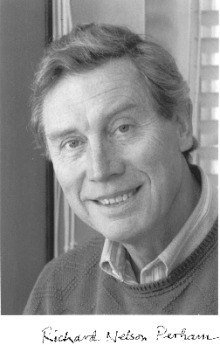Richard Perham | |
|---|---|
 | |
| Born | Richard Nelson Perham 27 April 1937 |
| Died | 14 February 2015 (aged 77) |
| Alma mater | University of Cambridge |
| Awards | |
| Scientific career | |
| Fields | Biochemistry |
| Institutions | St John's College, Cambridge; Department of Biochemistry, Cambridge; MRC Laboratory of Molecular Biology |
| Doctoral students | Nigel Scrutton[1] |
| Website | www |
Richard Nelson Perham, FRS, FMedSci, FRSA (27 April 1937 – 14 February 2015), was Professor of biochemistry at the University of Cambridge, and Master of St John's College, Cambridge 2004–07.[2][3] He was also editor-in-chief of FEBS Journal (Federation of European Biochemical Societies) from 1998 to 2013.[4][5]
Education
[edit]Perham attended Latymer Upper School, then St John's College, Cambridge, where he completed his MA (Cantab), PhD and ScD.[6] Perham then went on to become a MRC scholar at Laboratory of Molecular Biology (LMB), also at Cambridge.[2][7]
Research and career
[edit]Perham was known for his contributions to the chemistry of proteins in multimeric assemblies.[8][9]
Societies
[edit]Perham was a member of the following organisations and societies:[2]
- 1965 Biochemical Society member
- 1983 EMBO Member
- 1986 Royal Institution for Great Britain member
- 1992 Academia Europaea member
Awards and fellowships
[edit]His awards include:[2]
- 1971 (EMBO) fellowship Max Planck Institute for Medical Research (Max-Planck-Institut für Medizinische Forschung), Heidelberg
- 1984 Fellow of the Royal Society (FRS)[10]
- 1988 Fellow of the Royal Society of Arts (FRSA)
- 1993 Max Planck Research Prize
- 1998 Novartis Medal and Prize of the Biochemical Society
- 2000 Silver Medal of the Italian Biochemical Society
- 2005 Fellowship of the Academy of Medical Sciences (FMedSci)
- 2008 Edman Prize International Association of Protein Structure and Proteomics (IAPSAP)
- 2011 Diplôme d'Honneur of the Federation of European Biochemical Societies
Selected bibliography
[edit]- Perham, Richard N (1975). Instrumentation in amino acid sequence analysis. London New York: Academic Press. ISBN 978-0-12-551250-3.
- Perham, Richard N; Chapman, Stephen; Scrutton, Nigel (2002). Flavins and flavoproteins 2002: proceedings of the Fourteenth International Symposium, St. John's College, University of Cambridge, UK, July 14–18, 2002. Berlin: Rudolf Weber, Agency for Scientific Publications. ISBN 978-3-00-010229-5.
- Perham, Richard N; Baumeister, Wolfgang; Johnson, Louise; Steven, Alasdair (1975). Instrumentation in amino acid sequence analysis. London New York: Academic Press. ISBN 978-0-12-551250-3.
Personal life
[edit]Perham was married to Canadian cell biologist Nancy Lane Perham, and they had two children together.[6]
References
[edit]- ^ Scrutton, Nigel Shaun (1988). Mechanistic and structural studies on glutathione reductase by protein engineering (PhD thesis). University of Cambridge. OCLC 557267794.
- ^ a b c d "Richard Nelson PERHAM – Biography". Debretts. Retrieved 22 April 2014.
- ^ "Fellow – Professor Richard Perham FRS FMedSci". The Academy of Medical Sciences. Retrieved 22 April 2014.
- ^ Profile: Professor Richard Perham FRS FMedSci The Academy of Medical Sciences
- ^ Profile: Richard Nelson Perham Debretts
- ^ a b "Professor Richard Nelson Perham ScD FRS FMedSci, 1937–2015 | StJohns". www.joh.cam.ac.uk. Retrieved 27 March 2021.
- ^ "Professor Richard Perham 1937–2015". joh.cam.ac.uk. 16 February 2015.
- ^ Martin, Seamus J (January 2014). "Editorial – The FEBS Journal: passing the editorial baton". The FEBS Journal. 281 (1): 1–2. doi:10.1111/febs.12650. hdl:2262/75314. S2CID 83822402.
- ^ Parham, Peter (December 2013). "Editorial - R. N. Perham at the helm: 1998–2013". The FEBS Journal. 280 (24): 6279. doi:10.1111/febs.12585.
- ^ Berry, Alan; Radford, Sheena E. (2018). "Richard Nelson Perham. 27 April 1937–14 February 2015". Biographical Memoirs of Fellows of the Royal Society. doi:10.1098/rsbm.2018.0004
Well, that’s interesting to know that Psilotum nudum are known as whisk ferns. Psilotum nudum is the commoner species of the two. While the P. flaccidum is a rare species and is found in the tropical islands. Both the species are usually epiphytic in habit and grow upon tree ferns. These species may also be terrestrial and grow in humus or in the crevices of the rocks.
View the detailed Guide of Psilotum nudum: Detailed Study Of Psilotum Nudum (Whisk Fern), Classification, Anatomy, Reproduction